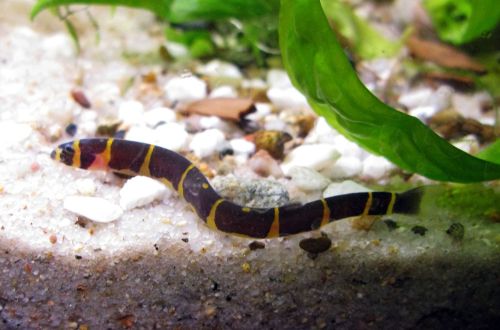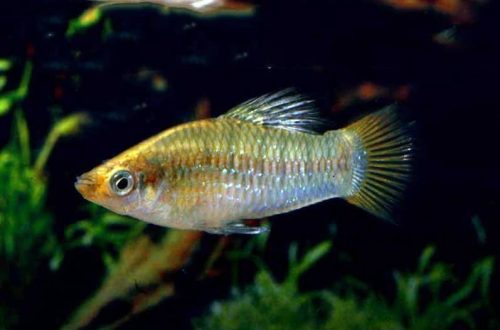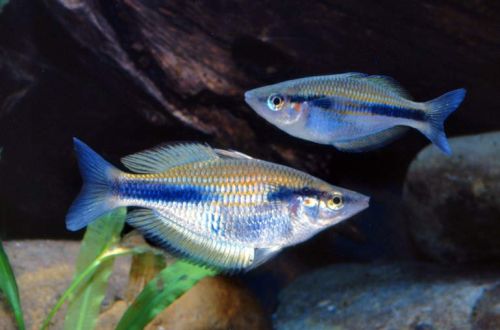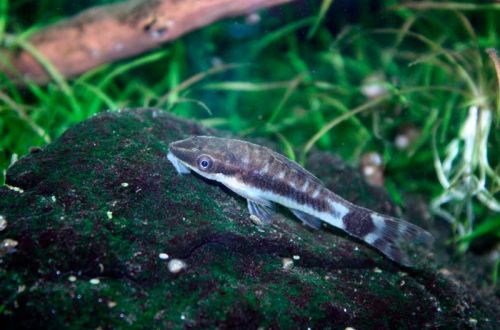
Acanthophthalmus
Acanthophthalmus semigirdled, scientific name Pangio semicincta, belongs to the Cobitidae family. On sale this fish is often called Pangio kuhlii, although this is a completely different species, almost never found in aquariums. The confusion arose as a result of erroneous conclusions by researchers who considered Pangio semicincta and Kuhl char (Pangio kuhlii) to be the same fish. This point of view lasted from 1940 to 1993, when the first denials appeared, and since 2011 these species have been finally separated.

Contents
Habitat
It comes from Southeast Asia from Peninsular Malaysia and the Greater Sunda Islands of Sumatra and Borneo. They live in shallow water bodies (oxbow lakes, swamps, streams) in the shade of tropical forests. They prefer places with stagnant water and dense vegetation, hiding in silted soil or among fallen leaves.
Brief information:
- The volume of the aquarium – from 50 liters.
- Temperature – 21-26°C
- Value pH — 3.5–7.0
- Water hardness – soft (1-8 dGH)
- Substrate type – any
- Lighting – subdued
- Brackish water – no
- Water movement is weak
- The size of the fish is up to 10 cm.
- Nutrition – any drowning
- Temperament – peaceful
- Keeping in a group of 5-6 individuals
Description
Adults reach 9-10 cm. The fish has a snake-like elongated body with small fins and a tail. Near the mouth are sensitive antennae, which are used to search for food in soft ground. The coloration is brown with a yellow-white belly and rings encircling the body. Sexual dimorphism is weakly expressed, it is problematic to distinguish a male from a female.
Food
In nature, they feed by sifting soil particles through their mouths, eating small crustaceans, insects and their larvae, and plant debris. In a home aquarium, sinking foods such as dry flakes, pellets, frozen bloodworms, daphnia, brine shrimp should be fed.
Maintenance and care, decoration of the aquarium
Aquarium sizes for a group of 4-5 fish should start from 50 liters. The design uses a soft sandy substrate, which Acanthophthalmus will regularly sift. Several snags and other shelters form small caves, next to which shade-loving plants are planted. To simulate natural conditions, Indian almond leaves can be added.
Lighting is subdued, floating plants will serve as an additional means of shading the aquarium. Internal water movement must be kept to a minimum. Optimum keeping conditions are achieved by replacing part of the water weekly with fresh water with the same pH and dGH values, as well as regular removal of organic waste (decaying leaves, leftover feed, excrement).
Behavior and Compatibility
Calm peace-loving fish, gets along well with relatives and other species of similar size and temperament. In nature, they often live in large groups, so it is advisable to purchase at least 5-6 individuals in an aquarium.
Breeding / breeding
Reproduction is seasonal. The stimulus for spawning is a change in the hydrochemical composition of water. Breeding this type of loach at home is quite problematic. At the time of writing, it was not possible to find reliable sources of successful experiments in the appearance of offspring in Acanthophthalmus.
Fish diseases
Health problems arise only in case of injuries or when kept in unsuitable conditions, which depresses the immune system and, as a result, provokes the occurrence of any disease. In the event of the appearance of the first symptoms, first of all, it is necessary to check the water for the excess of certain indicators or the presence of dangerous concentrations of toxic substances (nitrites, nitrates, ammonium, etc.). If deviations are found, bring all values back to normal and only then proceed with treatment. Read more about symptoms and treatments in the Aquarium Fish Diseases section.





